
With climate change causing sea levels to rise at an alarming rate and urban areas running out of space, innovative solutions are more critical than ever. Enter water-based architecture – a revolutionary approach to sustainable living that floats on water. This blog explores the environmental impact of water-based architecture, highlighting its benefits, challenges, and future potential. By delving into this emerging field, we aim to inspire a sustainable and resilient built environment.
Why Water-Based Architecture is Rising as a Solution to Climate Challenges
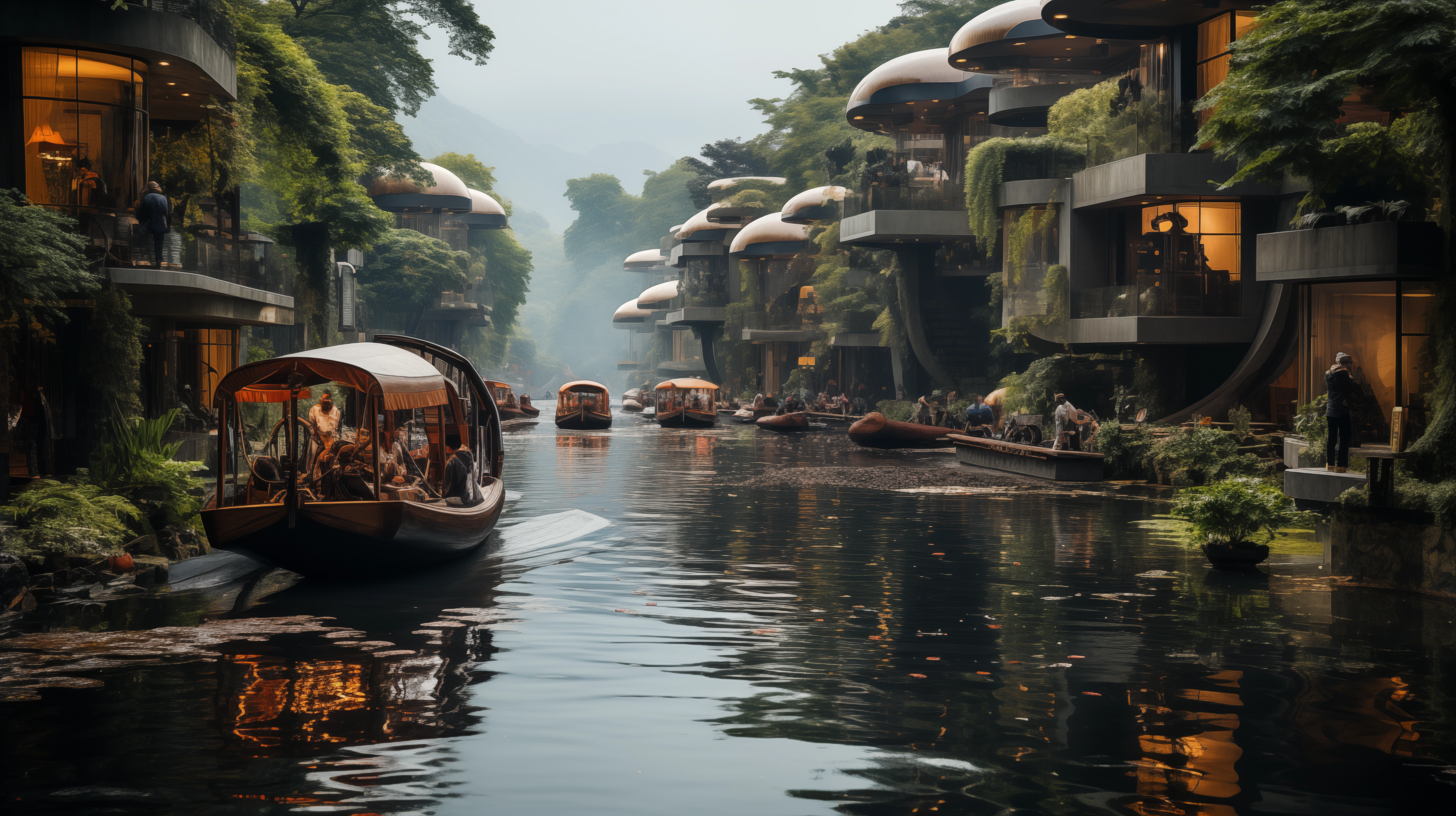 An urban canal scene highlighting the contrast between traditional boats and futuristic floating homes designed to adapt to rising water levels. This blend of old and new showcases innovative solutions for sustainable living in the face of climate challenges.
An urban canal scene highlighting the contrast between traditional boats and futuristic floating homes designed to adapt to rising water levels. This blend of old and new showcases innovative solutions for sustainable living in the face of climate challenges.
The Need for Innovative Solutions
The world is facing unprecedented environmental challenges. Climate change is causing sea levels to rise, leading to the loss of coastal land and increased flooding. Urbanization is putting pressure on available land, while traditional construction methods often result in significant environmental degradation. In this context, water-based architecture offers a promising solution that addresses these issues while promoting sustainability and resilience.
Pioneering Examples of Water-Based Architecture
Several pioneering projects around the world are demonstrating the potential of water-based architecture. From floating homes in the Netherlands to floating cities in Asia, these innovative developments showcase the versatility and feasibility of building on water. These projects serve as proof of concept, illustrating the numerous benefits and practical applications of this approach.
The Netherlands: Waterbuurt Neighbourhood
The Netherlands is a global leader in water-based architecture, with numerous projects showcasing the potential of floating homes. One notable example is the Waterbuurt neighborhood in Amsterdam, which features a collection of floating houses designed to adapt to changing water levels. These homes are built using sustainable materials and incorporate renewable energy systems, demonstrating the feasibility and environmental benefits of water-based living.
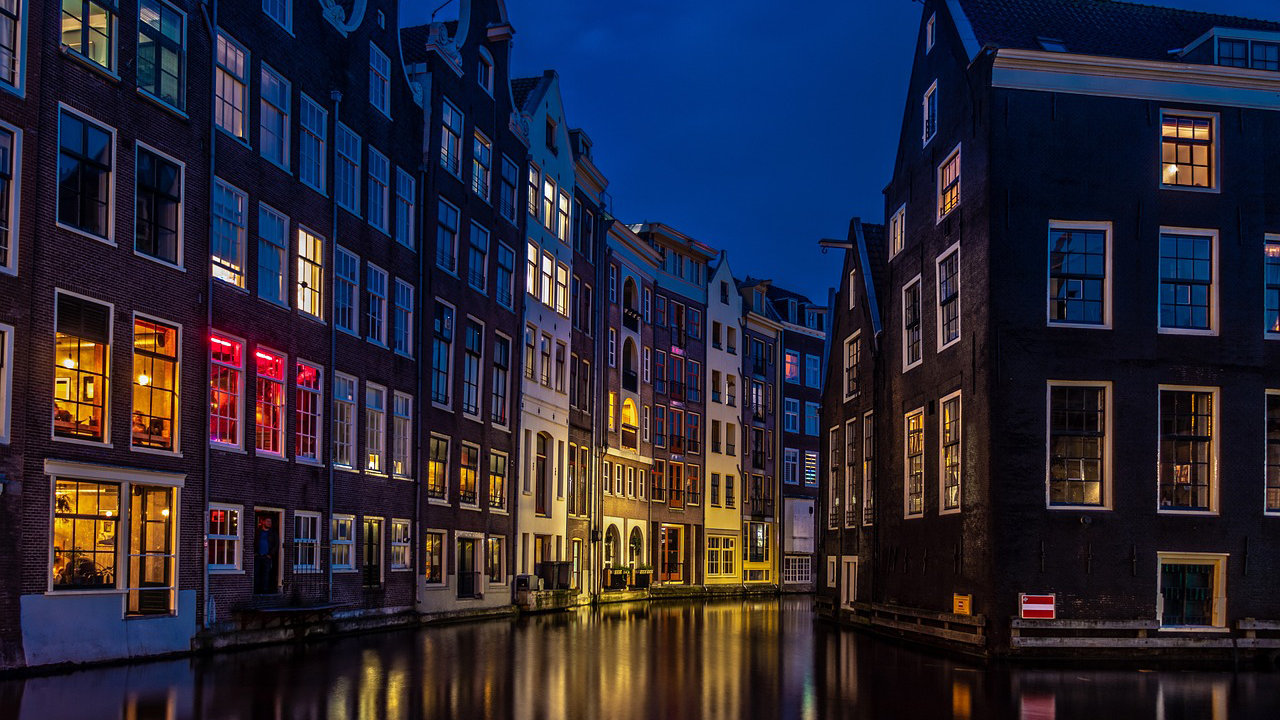 The Waterbuurt neighborhood in Amsterdam exemplifies the Netherlands' leadership in water-based architecture, featuring floating homes designed to adapt to changing water levels.
The Waterbuurt neighborhood in Amsterdam exemplifies the Netherlands' leadership in water-based architecture, featuring floating homes designed to adapt to changing water levels.
Japan: The Floating City of the Future
In Japan, the Shimizu Corporation has proposed the concept of the "Green Float," a futuristic floating city designed to address urbanization and climate change. This ambitious project envisions a series of floating modules that can support residential, commercial, and recreational spaces. The Green Float aims to be self-sufficient, utilizing renewable energy, water recycling, and sustainable agriculture to minimize its environmental impact.
The Maldives: Luxury and Sustainability
The Maldives, known for its pristine waters and luxury resorts, is also exploring water-based architecture. Projects like the Floating Island Project aim to create sustainable and resilient living spaces in response to rising sea levels. These floating islands are designed to blend seamlessly with the natural environment, offering luxury accommodations while prioritizing sustainability and environmental protection.
Discover the Maldives Floating City project, an innovative example of water-based architecture. This visionary initiative adapts to rising sea levels, integrating renewable energy and sustainable materials to create a resilient, eco-friendly living environment. Watch to see how cutting-edge design meets sustainability.
Environmental Benefits of Water-Based Architecture
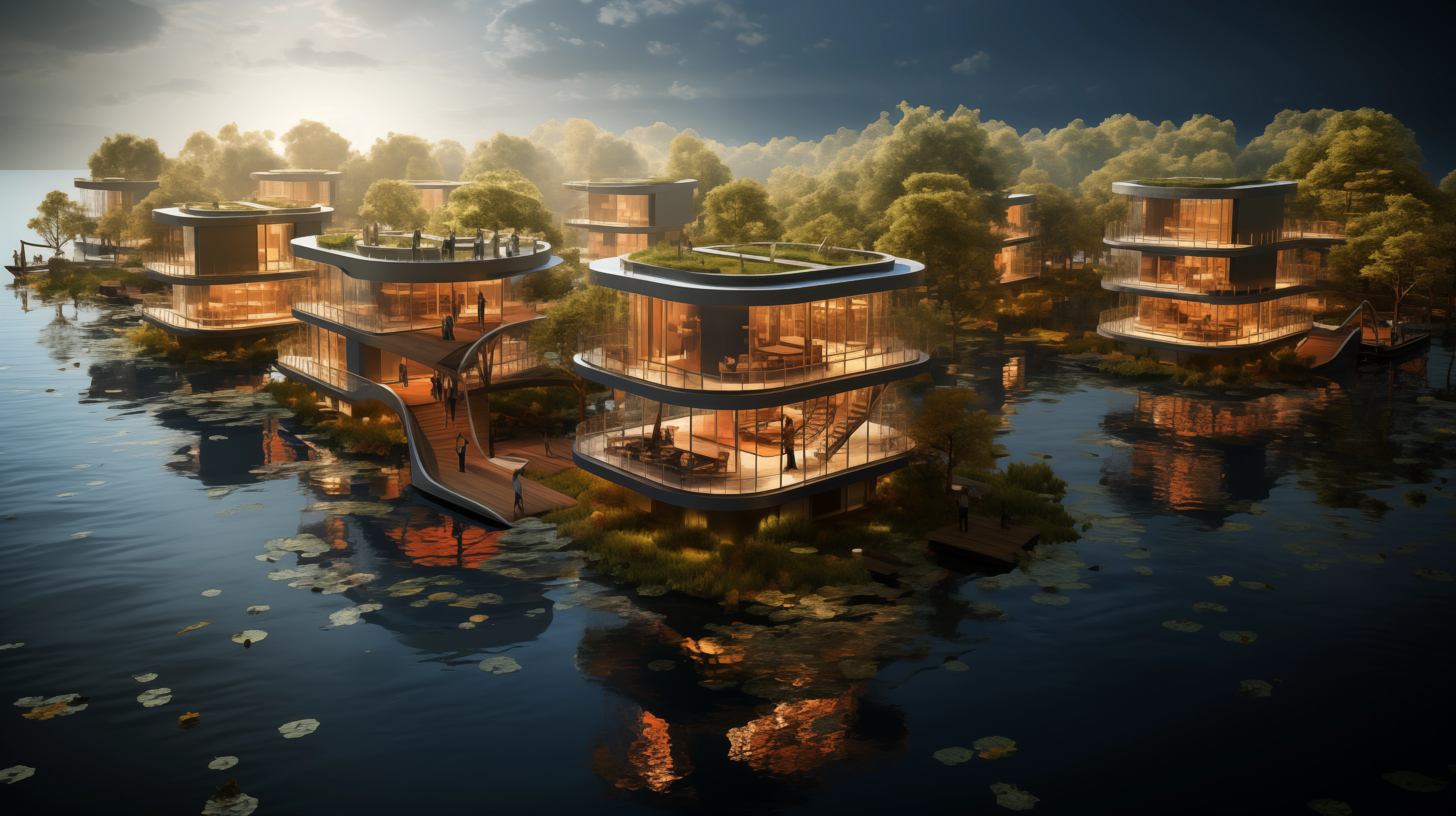 A serene floating community with modern, eco-friendly homes designed with solar panels and green rooftops. These structures harmoniously blend with the surrounding natural environment, demonstrating the potential of sustainable water-based living.
A serene floating community with modern, eco-friendly homes designed with solar panels and green rooftops. These structures harmoniously blend with the surrounding natural environment, demonstrating the potential of sustainable water-based living.
Reduced Land Use and Preservation of Natural Habitats
One of the most significant environmental benefits of water-based architecture is the reduction in land use. By building on water, we can preserve natural habitats and ecosystems that would otherwise be disrupted or destroyed by traditional construction. This approach helps to maintain biodiversity and protect the environment from further degradation. (United Nations)
Resilience to Climate Change
Water-based architecture is inherently resilient to climate change. Floating structures can adapt to rising sea levels and increased flooding, reducing the risk of damage and displacement. This adaptability makes water-based architecture a sustainable solution for coastal areas and other regions vulnerable to the impacts of climate change.
Sustainable Resource Management
Water-based architecture promotes sustainable resource management in several ways. For example, floating buildings can be designed to harness renewable energy sources such as solar and wind power. Additionally, these structures can incorporate systems for rainwater harvesting and wastewater treatment, reducing their reliance on external resources and minimizing their environmental footprint.
 A visionary floating community featuring sleek, modern homes with eco-friendly designs, situated along a serene waterway. This innovative approach to urban living integrates green spaces and emphasizes sustainability.
A visionary floating community featuring sleek, modern homes with eco-friendly designs, situated along a serene waterway. This innovative approach to urban living integrates green spaces and emphasizes sustainability.
Challenges and Considerations
Technical and Engineering Challenges
Building on water presents unique technical and engineering challenges. Floating structures must be designed to withstand the dynamic forces of water, including waves, currents, and tides. This requires innovative engineering solutions and materials that can provide stability, durability, and safety. Innovations like lightweight composite materials and flexible anchoring systems are being developed to enhance stability and durability.
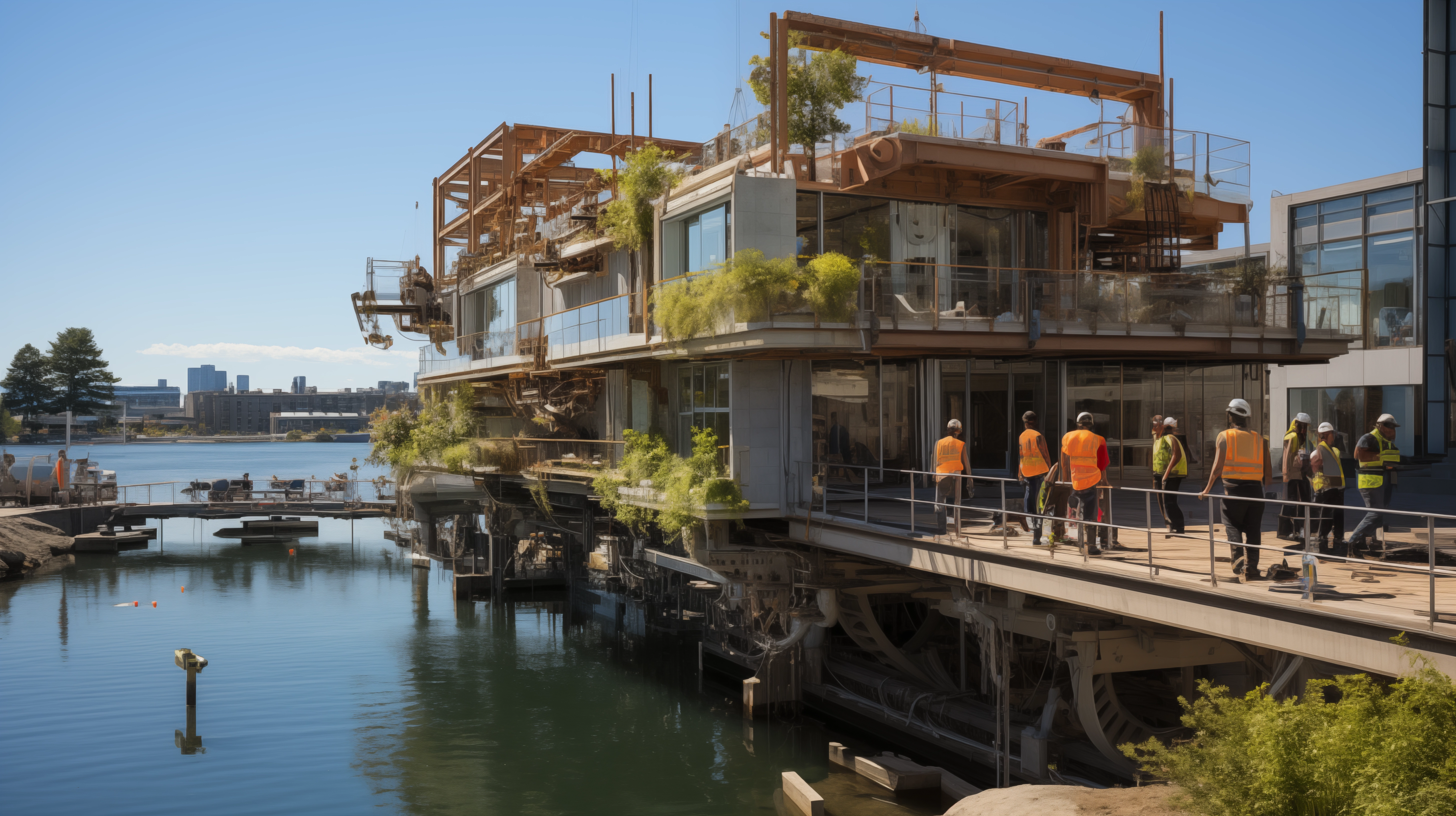 Engineers and construction workers collaborating on the construction of a modern floating structure. The project showcases the use of advanced materials and innovative techniques to create sustainable water-based architecture.
Engineers and construction workers collaborating on the construction of a modern floating structure. The project showcases the use of advanced materials and innovative techniques to create sustainable water-based architecture.
Environmental Impact During Construction
While water-based architecture offers many environmental benefits, it is essential to consider the potential impact during construction. Building on water can disturb aquatic ecosystems and wildlife, particularly if not managed carefully. Mitigating these impacts requires careful planning, sustainable construction practices, and ongoing environmental monitoring.
Regulatory and Legal Frameworks
The development of water-based architecture also faces regulatory and legal challenges. Existing building codes and regulations are primarily designed for land-based structures, and adapting these frameworks to accommodate floating buildings can be complex. Additionally, issues related to property rights, zoning, and environmental protection must be addressed to ensure the successful implementation of water-based architecture.
Future Potential of Water-Based Architecture
Urban Expansion and Population Growth
As urban populations continue to grow, the demand for housing and infrastructure increases. Water-based architecture offers a viable solution for urban expansion, providing new living spaces without encroaching on valuable land. Floating cities and neighborhoods can accommodate growing populations while promoting sustainable development and reducing environmental impacts.
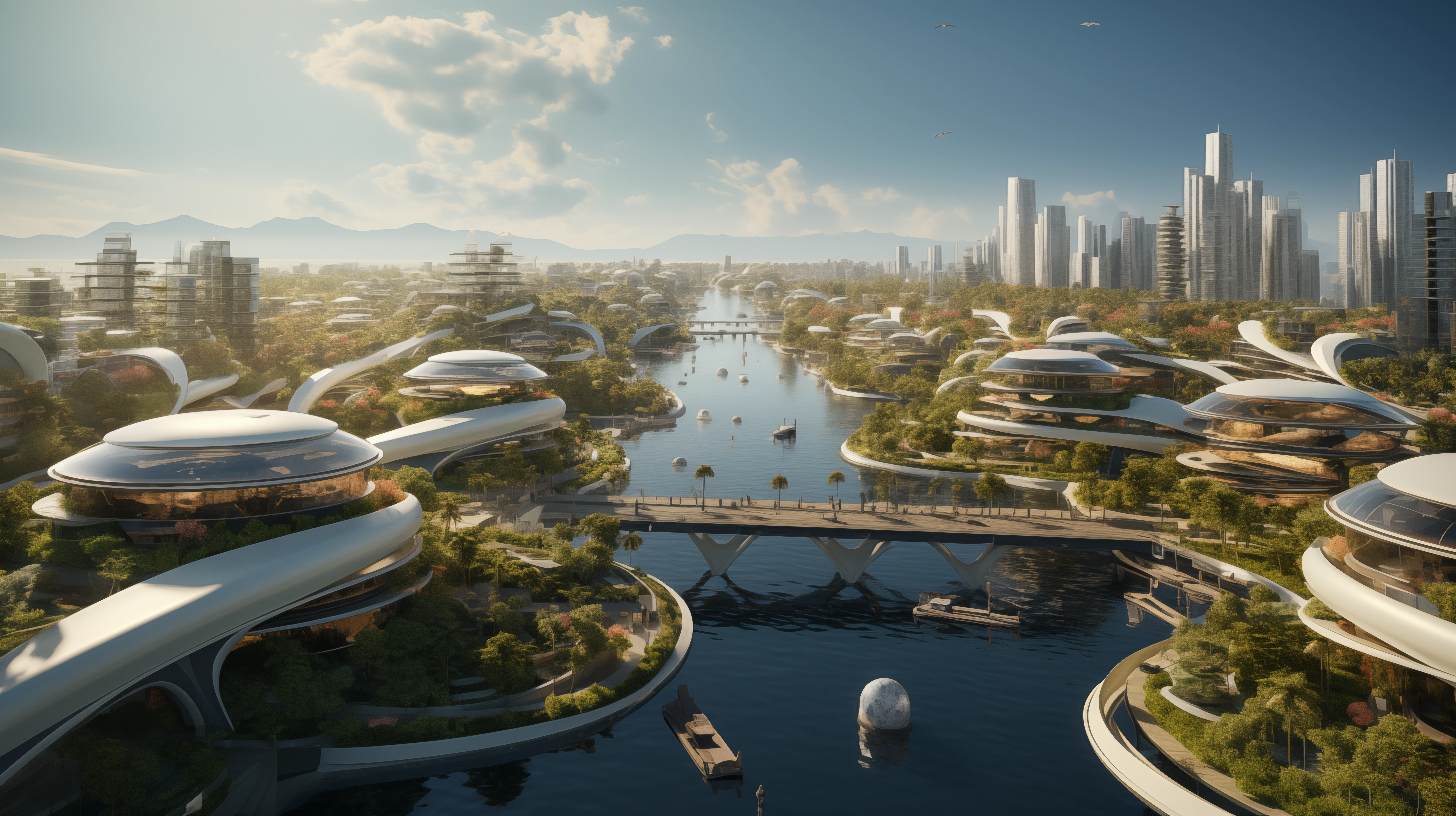 A futuristic floating city designed to accommodate growing urban populations, featuring sleek modern buildings, advanced materials, and integrated green spaces. This innovative urban design promotes sustainable living on water.
A futuristic floating city designed to accommodate growing urban populations, featuring sleek modern buildings, advanced materials, and integrated green spaces. This innovative urban design promotes sustainable living on water.
Innovation in Design and Materials
The rise of water-based architecture is driving innovation in design and materials. Architects and engineers are developing new techniques and materials that enhance the performance and sustainability of floating structures. For example, advancements in lightweight and durable materials, such as composite fibers and recycled plastics, are making water-based architecture more feasible and environmentally friendly.
Enhancing Coastal and Marine Environments
Water-based architecture has the potential to enhance coastal and marine environments. Floating structures can serve as artificial reefs, providing habitats for marine life and promoting biodiversity. Additionally, these structures can be designed to incorporate green spaces and vegetation, contributing to the overall health and resilience of aquatic ecosystems.
The Role of Technology in Water-Based Architecture
Smart and Connected Systems
Technology plays a crucial role in the development and operation of water-based architecture. Smart and connected systems can enhance the efficiency, safety, and sustainability of floating structures. For example, sensors and monitoring systems can provide real-time data on structural integrity, water quality, and energy consumption, enabling proactive maintenance and optimization.
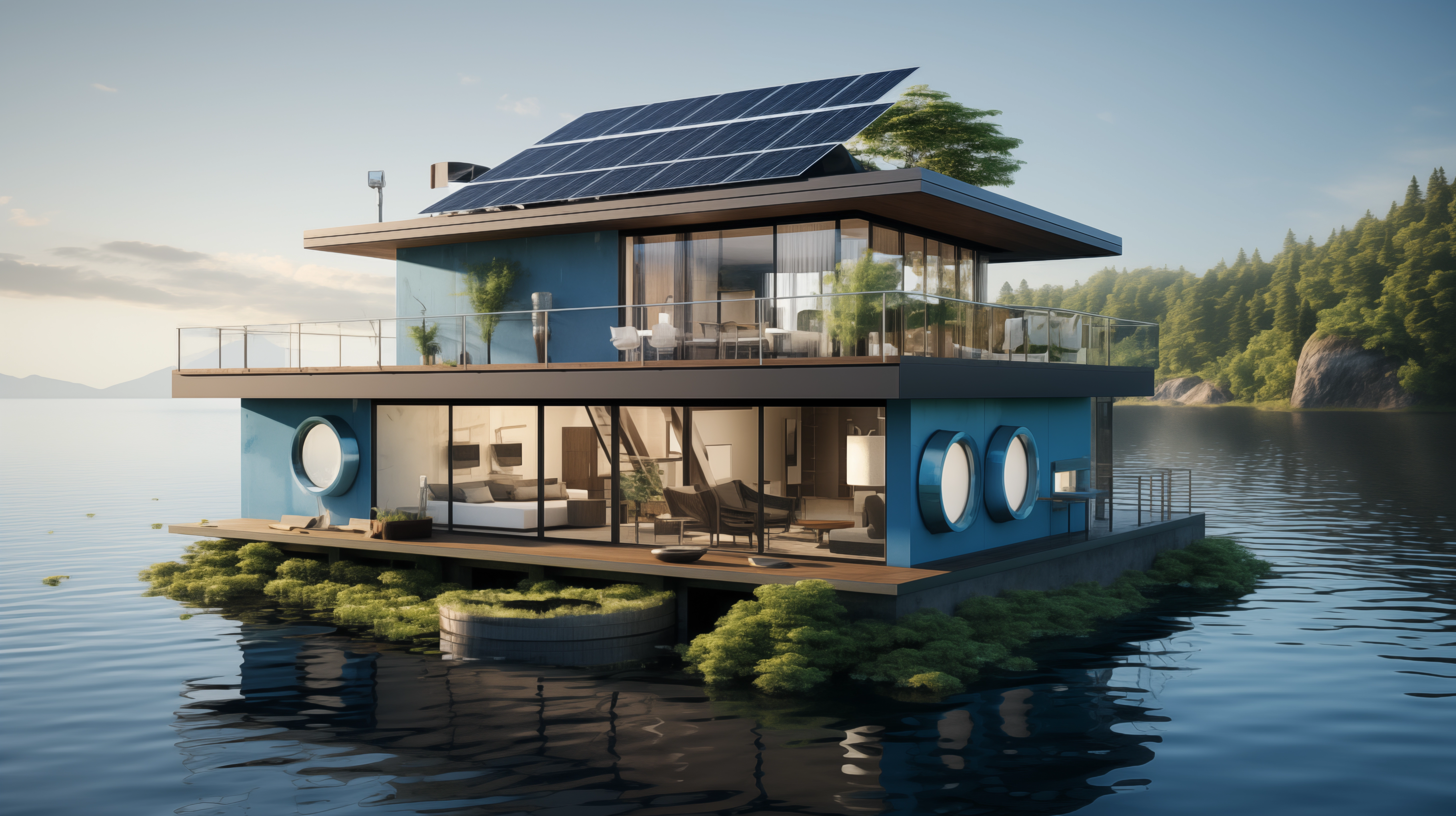 A modern smart floating home equipped with solar panels, advanced water recycling systems, and real-time monitoring technology. This innovative design showcases the integration of sustainable living and advanced technology.
A modern smart floating home equipped with solar panels, advanced water recycling systems, and real-time monitoring technology. This innovative design showcases the integration of sustainable living and advanced technology.
Renewable Energy Integration
Integrating renewable energy sources is essential for the sustainability of water-based architecture. Floating structures can be equipped with solar panels, wind turbines, and other renewable energy systems to generate clean power. Additionally, advancements in energy storage and distribution can ensure a reliable and efficient energy supply for floating communities.
Advanced Materials and Construction Techniques
The development of advanced materials and construction techniques is critical for the success of water-based architecture. Lightweight, durable, and sustainable materials can improve the performance and longevity of floating structures. Innovations in modular construction and prefabrication can also streamline the building process, reducing costs and environmental impacts.
Social and Economic Implications
Creating New Economic Opportunities
Water-based architecture can create new economic opportunities, particularly in coastal and island communities. The development of floating structures can stimulate local economies by creating jobs in construction, maintenance, and tourism. Additionally, these projects can attract investment and promote economic diversification, enhancing the resilience of coastal regions.
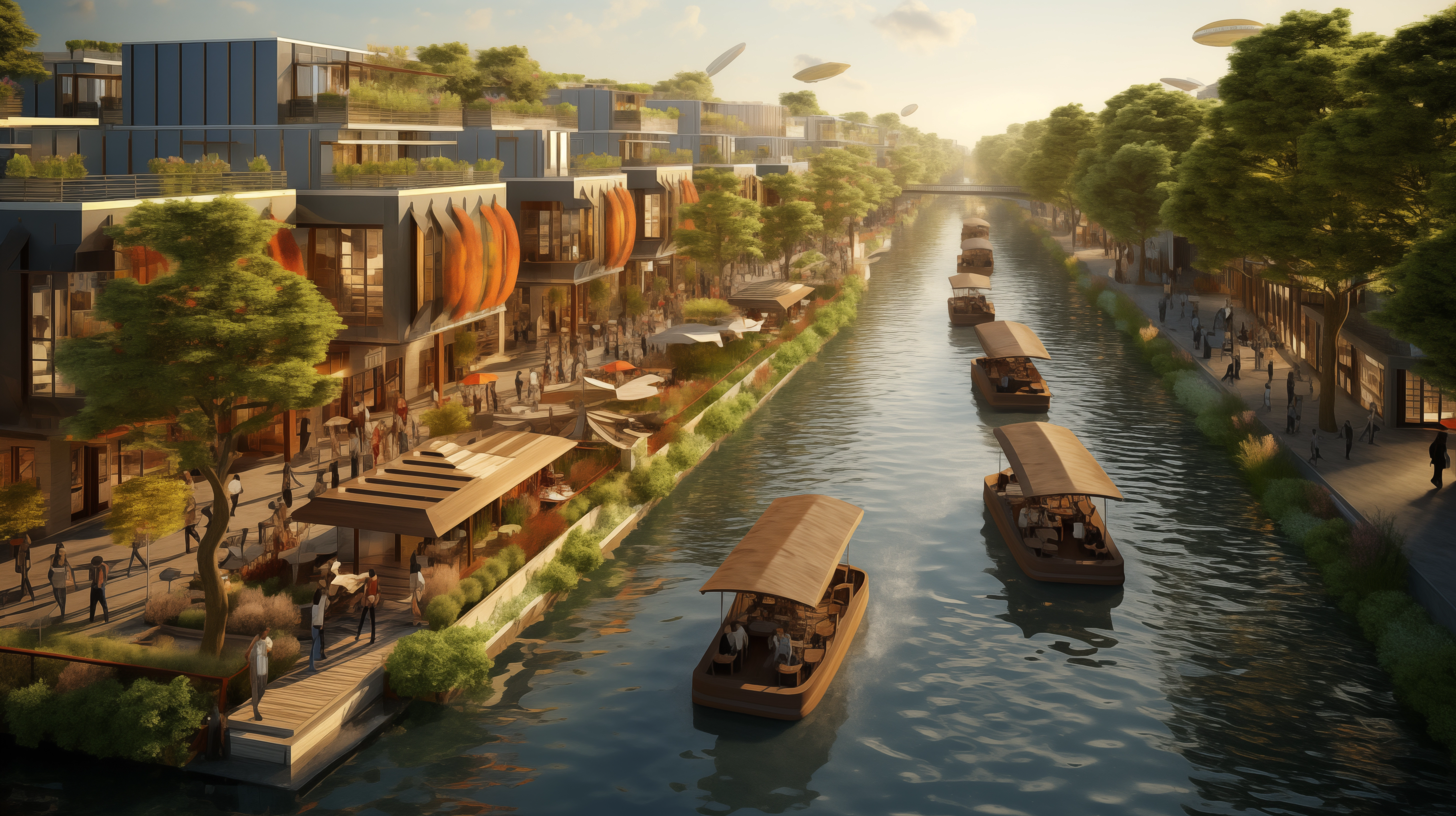 A vibrant floating community featuring diverse populations enjoying recreational spaces and engaging in various economic activities along a bustling canal. This scene highlights the enhanced quality of life and economic opportunities provided by water-based living.
A vibrant floating community featuring diverse populations enjoying recreational spaces and engaging in various economic activities along a bustling canal. This scene highlights the enhanced quality of life and economic opportunities provided by water-based living.
Enhancing Quality of Life
Floating communities can offer a high quality of life, with access to unique amenities and natural surroundings. Water-based living can provide residents with a sense of connection to the environment and promote a sustainable lifestyle. Furthermore, the adaptability and resilience of floating structures can enhance safety and security in the face of environmental challenges.
Addressing Social Inequities
Water-based architecture has the potential to address social inequities by providing affordable and accessible housing solutions. Floating homes and communities can be designed to accommodate diverse populations, offering a range of housing options to suit different needs and budgets. By promoting inclusivity and social equity, water-based architecture can contribute to more sustainable and just urban development.
Conclusion
Embracing a Floating Future
The environmental impact of water-based architecture is profound, offering a sustainable and resilient solution to some of the most pressing challenges of our time. By reducing land use, enhancing climate resilience, and promoting sustainable resource management, floating structures can contribute to a more sustainable and equitable built environment.
The Path Forward
As we look to the future, it is essential to continue exploring and advancing water-based architecture. This requires collaboration between architects, engineers, policymakers, and communities to overcome technical, regulatory, and social challenges. By embracing innovation and prioritizing sustainability, we can unlock the full potential of water-based architecture and pave the way for a floating future.
Final Thoughts
The journey towards a floating future is just beginning, and the possibilities are limitless. As we navigate this uncharted territory, it is crucial to remain committed to sustainability, resilience, and inclusivity. Water-based architecture holds the promise of transforming our built environment, creating vibrant, sustainable communities that thrive on water. Let us embrace this opportunity and work together to build a better, floating future for generations to come.









